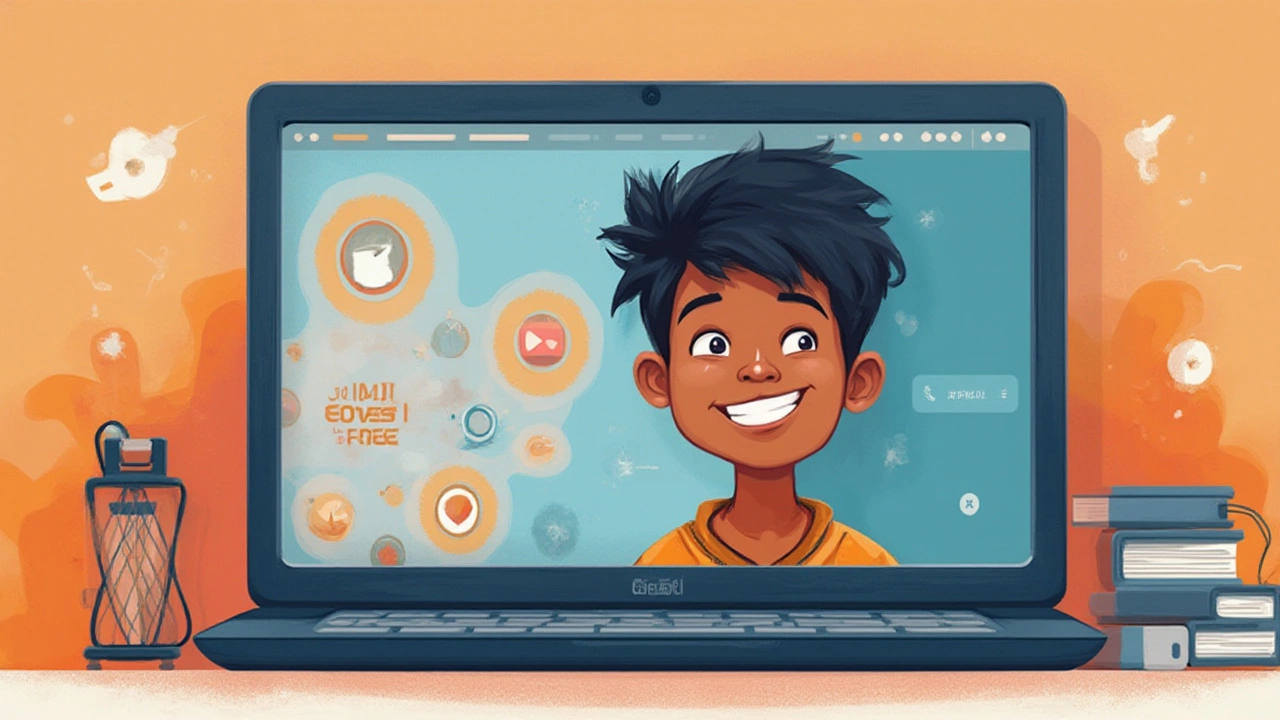Picture this: you’ve spent hours tinkering with your website—colors, fonts, all the small details that make it feel personal and real. But then comes the real test. Can you park it on the wild web for free, without your wallet screaming for mercy? Short answer: yes, you can. But, like parking spots in a crowded city, there’s always a catch. If you know where to look, though, you can get your project live for zero dollars and even keep your pride intact.
What Does It Actually Mean to Put a Website Online for Free?
When people say "put your website online for free," it's usually about two things: free hosting and a website builder you don’t have to pay for. Hosting is the space your website needs to sit on the Internet—like digital real estate. Some people spend a fortune renting out these spots, but many companies offer free basic lots to get you started.
There are basically three primary paths here: Using hosted website builders (like Wix or WordPress.com), relying on free static hosting services (think GitHub Pages or Netlify), or using limited free hosting from traditional providers. Each one gives you a slightly different set of perks and gotchas.
Now, if you’re hoping to launch your own big ecommerce shop for free, you’ll get stopped by some hurdles. But for a portfolio, a personal blog, a resume, or a basic business site? Free options usually work out just fine. People have been putting everything from wedding invites to online CVs using these tools, no tech degree required.
But remember, your free setup often comes with a randomly generated, awkward URL (like yourname.wixsite.com/coolproject) and some gentle advertising for the host you’re using. If you want your own custom .com, you’ll need to buy it yourself—but we’ll cover some clever ways to look semi-professional for nothing.
And yes, free hosts sometimes have decent reliability. GitHub Pages, for example, hosts documentation for projects used by companies running everything from banking apps to search engines. The catch? Your website can’t be too complex or dynamic (think moving parts like user logins or ecommerce carts), but for static websites—the kind you just want to show stuff—it’s rock solid.
So, summing up, putting a site online for free means picking a free hosting plan, possibly using a drag-and-drop builder, and living with a slightly odd domain name until you’re ready to upgrade. The startup costs are still zero.
Top Free Website Hosting Platforms: What You Really Get (and What You Don’t)
Let’s be honest—no one likes hidden trade-offs. Free usually means a few limits. The good news? There’s a buffet of totally free website hosting providers that actually deliver decent quality with minimal strings attached. Here’s the rundown on some well-known free services and what to expect from each.
- Wix: You get a super-friendly drag-and-drop interface, tons of ready-made designs, and no coding needed. In exchange, you have to settle for a .wixsite.com subdomain and some small Wix ads on your pages. Still, it’s one of the fastest ways to get a slick personal portfolio or event site live in under an hour.
- WordPress.com: Offers blog-style layouts, solid reliability, and automatic backups. That said, you’re using a .wordpress.com subdomain and can’t use custom plugins or full themes unless you upgrade. But for a free blog, it’s hard to beat.
- GitHub Pages: Here’s the secret weapon for anyone with just a pinch of coding knowledge. You create static websites hosted right from your GitHub repository, with a surprisingly fast global network. No ads, but you’ll need to know a bit about HTML and Git.
- Netlify: Like GitHub Pages but with more bells and whistles. Supports free static site hosting, continuous deployment (push changes and your site updates in minutes), and handy previews for every new version. Excellent for anyone working with static site generators or simple HTML/CSS pages.
- Google Sites: Offers fast, dead-simple builder tools for basic sites or internal team spaces. No ads, but design choices are very limited and you can’t add fancy features. Think projects, class assignments, or quick business wikis.
- Neocities: The descendant of late-90s GeoCities, it’s meant for simple static sites and personal projects. Super easy for beginners, but no back-end stuff and a strict site size limit.
To compare the basics, check out this quick table:
| Provider | Custom Domain? | Ads? | Storage | Technical Skills |
|---|---|---|---|---|
| Wix | No (free tier) | Yes | 500MB | None |
| WordPress.com | No (free tier) | Yes | 1GB | None |
| GitHub Pages | Yes | No | 1GB | Basic coding |
| Netlify | Yes | No | 100GB/month bandwidth | Basic coding |
| Google Sites | No | No | Unlimited within Google Drive | None |
| Neocities | No (free) | No | 1GB | Basic HTML |
The takeaway? If design comes first and having a personal website right away matters, Wix or WordPress.com wins. If you don’t mind learning some code or want a completely ad-free result (with a custom domain later on), check out GitHub Pages or Netlify. Remember, your website’s complexity is the main deal breaker—free hosts usually stick to the basics. But for most basic needs, they honestly get the job done.

How To Publish Your Website for Free: Step-by-Step Guide
Starting from scratch? Here’s a quick roadmap for anyone who wants to put their own site online with a budget of literal zero. You don’t need any previous experience, though being able to copy and paste, follow instructions, and a pinch of patience will help a ton.
- Pick Your Builder or Host
Choose a platform that fits your style. Want drag-and-drop? Go with Wix or WordPress.com. Don’t mind Markdown and HTML? Try GitHub Pages or Netlify. Sign up for your chosen platform. - Create or Upload Your Website Files
Either use the platform’s built-in editor (Wix, Google Sites) to make your pages, or upload your files (HTML, CSS, images) if you’re coding by hand (Netlify, GitHub Pages). - Customize Your Site
Pick a theme or template that feels like you. Set up your menu, add your own content, toss in your images or videos, and tweak colors or fonts. On code-based hosts, edit the HTML and preview changes before publishing. - Publish and Share
Hit the publish button. Your site is now live on the web, usually on a subdomain. Share your new link on social media, your resume, business cards, or wherever you want folks to visit. - Add a Custom Domain Later (Optional)
Buy a domain (like yourname.com) from a registrar when you’re ready for a more polished look. Both Netlify and GitHub Pages will let you attach your domain to your free-hosted project, so you can look professional without paying ongoing hosting costs.
Here’s a tip that saved me headaches: Test your site from your phone’s browser, too—not just on a laptop. Some designs look wildly different on mobile, and you’ll want your site to be readable everywhere (including at 2am, when you remember you need to show someone your portfolio at breakfast).
If you’re ever stuck, most platforms have legit documentation and video guides. Even Midnight, my cat, could probably follow a step-by-step Netlify tutorial if she cared enough (she doesn't—she mostly naps on my keyboard).
What You Miss Out On With Free Hosting (and Why That’s Sometimes Fine)
Here’s where the honest talk comes in—free comes with limits, no matter how good the offer sounds. The main catch? Your website will usually sit on a subdomain, so instead of mycoolshop.com, you get something like mycoolshop.netlify.app or mycoolsite.wordpress.com. For some, that's no biggie. For businesses aiming for cred, it can look less professional.
The next thing you’ll notice is those tiny advertisements or branded footers. Wix, for example, places its name discretely on your page. WordPress.com adds a similar note. For a personal site or blog, few guests care. If you’re running a business, you might want to keep your brand front and center with a paid upgrade later.
Don’t forget about limitations on plugins and custom code. Some platforms, especially WordPress.com’s free tier, don’t let you install your own plugins or mess with the core files. If your idea is wild (say, an interactive tool or advanced store), you’ll get stuck eventually. Same goes for website data—advanced visitor tracking, custom signups, or email marketing tools might not be allowed on free tiers.
Lastly, there’s support. Not all free hosts offer live human help. It’s usually community forums, DIY FAQ guides, or email tickets that may take a while. If uptime is life-or-death (like for an important event or business launch), think twice before relying only on a free hosting plan.
But sometimes these limits are just fine. If you’re building a resume site, a simple event invite, or a school project, paying isn’t really necessary. And for learning the ropes or testing ideas, free hosting is genius—you learn fast with zero risk.

Tips for Making Your Free Website Stand Out Without Spending a Dime
Going free doesn’t mean you have to settle for “blah” or “cookie-cutter.” If you’re crafty and willing to learn a few tricks, you can stretch what’s possible on a free website way past average. Here’s what works:
- Work with solid templates. Every major platform hands you a template starter pack. Look for ones clean and modern—skip those that feel ancient. Preview your template on different devices before you commit.
- Personalize your design. Change images to your own, test out color combos that pop (a color palette generator can help if you feel stuck), and update every bit of dummy text. Your voice and visuals matter more than any logo on the footer.
- Compress your images. Free hosts usually limit storage and bandwidth. Use a tool like TinyPNG or Compressor.io to squeeze images extra small before uploading. Sites load instantly, and nobody waits for a slow .png to finish anymore.
- Proofread, then proofread again. Typos turn off visitors fast. Run your text through free services like Grammarly or Hemingway before launching.
- Use free, copyright-safe visuals. Sites like Unsplash, Pexels, or Pixabay give you professional-quality images or backgrounds without any legal hassles. No need for ugly generic stock.
- Link up social profiles. Add your LinkedIn, Instagram, or YouTube if it fits. It adds credibility (plus, visitors can find you outside the website itself).
- Get a custom email forwarder. Even if you don’t grab a custom domain yet, services like Mailgun or ImprovMX let you forward your email to something more professional, like [email protected] (once you get that domain).
- Monitor traffic with free analytics. If your platform allows, hook up Google Analytics or Plausible’s free trial. You’ll spot which pages get read (and which collect digital dust).
Above all, keep updating your site every few months, even if it’s just a quick tweak to your portfolio or bio. Freshness signals you care and keeps even free websites feeling brand-new.
If you want the most bang for absolutely no buck, here’s the magic: focus on free website hosting options that let you upgrade later. Test layouts, get feedback, find your groove on their dime. When you’re ready, snag your own domain or add advanced features—no wasted effort or locked-in contracts. Midnight, my cat, agrees: why pay for your website while you’re still experimenting?



